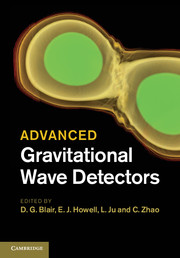Book contents
- Frontmatter
- Contents
- List of contributors
- Foreword
- Preface
- Introduction
- Part 1 An introduction to gravitational wave astronomy and detectors
- Part 2 Current laser interferometer detectors – three case studies
- Part 3 Technology for advanced gravitational wave detectors
- 9 Lasers for high optical power interferometers
- 10 Thermal noise, suspensions and test masses
- 11 Vibration isolation
- 12 Interferometer sensing and control
- 13 Stabilising interferometers against high optical power effects
- Part 4 Technology for third generation gravitational wave detectors
- Index
11 - Vibration isolation
from Part 3 - Technology for advanced gravitational wave detectors
Published online by Cambridge University Press: 05 March 2012
- Frontmatter
- Contents
- List of contributors
- Foreword
- Preface
- Introduction
- Part 1 An introduction to gravitational wave astronomy and detectors
- Part 2 Current laser interferometer detectors – three case studies
- Part 3 Technology for advanced gravitational wave detectors
- 9 Lasers for high optical power interferometers
- 10 Thermal noise, suspensions and test masses
- 11 Vibration isolation
- 12 Interferometer sensing and control
- 13 Stabilising interferometers against high optical power effects
- Part 4 Technology for third generation gravitational wave detectors
- Index
Summary
The suppression of seismic ground motion is a significant challenge for ground based gravitational wave interferometric detectors. It is generally achieved through different combinations of active isolation and passive isolation. This chapter will look at two different vibration isolation systems. Part 1 will describe the mostly active vibration isolation system used by LIGO. Part 2 will discuss the mostly passive isolation systems developed at the University of Western Australia, which have features in common with isolation systems developed for many other detectors.
Seismic isolation for Advanced LIGO
Lantz for the LIGO Scientific Collaboration
One of the most significant improvements for Advanced LIGO will be to move the lower edge of the detection band from 40 Hz down to 10 Hz. This will allow us to start tracking the final inspiral of compact binary systems earlier in their evolution, and will also allow us to observe the inspirals not only of pairs of neutron stars, but also of binary systems containing more massive objects, such as black holes with 10 to 30 times the mass of the Sun, as described in Chapter 4. In order to measure gravitational waves at 10 Hz, the requirements for the motion of the Advanced LIGO mirrors are very strict. The Advanced LIGO interferometer cannot distinguish between differential length changes in the arms caused by the spacetime distortion of a passing gravitational wave and differential length changes caused by mirror motion. For an interesting discussion about interferometer configurations where this might not be true, see recent work by Kawamura and Chen (2004) and others.
Information
- Type
- Chapter
- Information
- Advanced Gravitational Wave Detectors , pp. 202 - 226Publisher: Cambridge University PressPrint publication year: 2012
